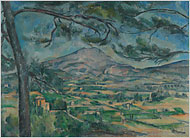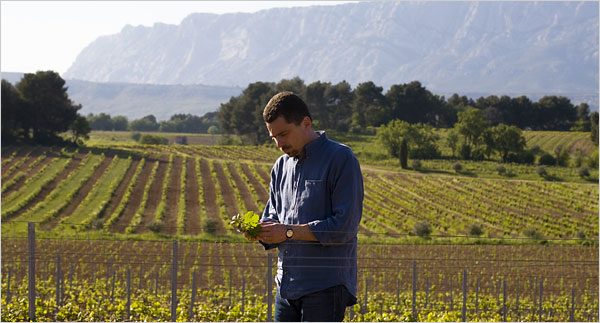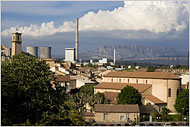AIX-EN-PROVENCE, France ? Squinting into the sun, Olivier Sumeire pointed to where his vineyard stretches across the Vall?e de l’Arc in the direction of Montagne Ste.-Victoire. The gray limestone mass looms beyond his children’s backyard play set, rising out of the olive trees and pines.

C?zanne’s “Montagne Ste.-Victoire,” painted in the 1880s, shows the peak near Aix with its railroad trestle, then new.

President Nicolas Sarkozy in La Rochelle in southern France last February announcing plans for a new high-speed rail line.
It happens that C?zanne painted nearly the same view. In 1870, in what has sometimes been interpreted as a protest against the proposed Aix-Rognac railway line that would have cut across his family’s property, not far from the Sumeire vineyard, he painted the mountain in the background and a kind of red gash in the landscape. Then in the 1880s he showed the rail line that connected Aix to Paris, dividing the valley, turning its arched trestle into an ancient aqueduct, as if to conjure up some Arcadian dream of unspoiled nature before modernity arrived.
C?zanne was Aixois through and through, allergic to change. Before he was born, in 1839, residents here had fought to stop any train from coming to town. But in the 1860s the train also carried C?zanne to Paris, where he learned about modern art, which transformed how he painted this place once he returned home. That in turn reshaped this region’s view of itself when, years after he died in 1906, townspeople finally came around to acknowledging his genius and marketability.
Plus ?a change.
A new plan promoted by President Nicolas Sarkozy, floated by local newspapers last year, would extend the high-speed, or TGV, rail line from Aix to Nice. The proposal is part of Mr. Sarkozy’s program to update rail service in coordination with European Union energy policies. Not incidentally, it’s also embraced by his political allies in the center-right government of Nice.
Naturally, the Aixois are back on the barricades.
Culture is the lens through which people see themselves, in this case a culture that C?zanne passed along. The train track, which would slice a new, conspicuous swath through the valley, in full view of the mountain, would among other things reconfigure the Sumeire property, which to be precise lies in the village of Trets, a few miles outside Aix. Mr. Sumeire, 41, who is president of the local vintners’ union, was appalled, and began to organize demonstrations. They have brought out thousands of protesters, among them wine producers and local politicians, shouting the slogan “Wake up, C?zanne, they’ve all gone mad!”
Mr. Sumeire, warming to the role of rabble-rouser, even came up with names for the demonstrations. For a protest in August (“Grapes of Wrath,” he dubbed it), a rented truck, with “TGV Non” painted on its hood, was driven around for 24 hours, blasting train noise at 120 decibels.
The French news media ate up that stunt. After some 5,000 people turned up for a rally in February in Aix, a government panel was appointed by Jean-Louis Borloo, the minister of the environment, to re-examine the rail line and alternate routes, including one from Marseille to Nice along the coast, through Toulon, skipping Aix, a project that would be costlier ($15 billion versus $11 billion, according to the latest estimate) and lengthen the trip to Paris (by about 10 minutes) but serve more people. The report to Mr. Sarkozy is due in mid-June.
Meanwhile, Philippe C?zanne, 68, the artist’s great-grandson, has joined the battle to save what protesters are always careful to remind everyone is “C?zanne country.” “Ste.-Victoire, up to now, is more or less as it was for centuries,” he said the other day, by telephone from Switzerland, where he was convalescing after a ski accident. “Now you have the highways, of course, but there is still the charming little C?zanne road around the mountain, which he loved to walk along, and which my father was involved in stopping back in the ’50s when there was a plan to adapt it to cars. We live with modernity today, but in this case there is another solution.”
Maybe, although Jean-Claude F?raud, the mayor of Trets and Mr. Sumeire’s cousin (after all, it’s a small town), is skeptical that Aix will ultimately dodge the speeding bullet train. “The decision will be political in the end,” he said. Behind his large desk in the tiny city hall, he shrugged.
“This is France,” he said. “I have my own vineyard” ? from a drawer he then produced a label for L’Anticaille Ste.-Victoire ? “but there are also wineries in Toulon, and they won’t be happy with the other route. The best argument we have is the preservation of C?zanne’s landscape.”
Jean-Michel Cherrier, who is helping to put together the new government report, knows that argument and all the others only too well. “We have protests everywhere the train might go,” he said, trying not to sound fatigued by the fuss. “Everybody who potentially lives near it has a reason to protest. Our study will take into account the protests, preservation of the region, economics, tourism, local politics, demographics, but in the end we have to pass by somewhere.”
And so history may repeat itself. There was the train that C?zanne protested against, because it was to run through his family property. Now there’s another train that may transgress against what’s become known as C?zanne country.
“Do you remember the pine tree on the bank of the River Arc, which bent its shaggy head over the wide pool extending at its feet?” the artist wrote at 19, imitating Virgil, to his boyhood friend ?mile Zola, who had just moved to Paris. Nostalgia, it’s useful to recall, always shaped his art, which was radically modern but harked back to old masters like Poussin and Claude Lorrain by turning scenes outside his door into elegies of bygone splendor.
Other modernists painted urban chaos and rapid change. C?zanne excised the factories around Aix. These days, a hike up Montagne Ste.-Victoire provides a view of Marseille and the sea, beyond the stacks of a power station. C?zanne saw eternal beauty, not industrial progress. He was the first to fixate on Ste.-Victoire as a sacred symbol of raw wildness in the middle of civilization, Provence’s Mount Fuji, in pictures where the mountain consumes even the houses multiplying around its southern slope, which he makes blend right into the rocks.
And that’s how people here now see the place, including Bruno ?ly, a C?zanne expert and director of the Granet Museum in Aix, whose family has lived here for generations. I found him in the museum busily putting the finishing touches on a C?zanne and Picasso show to open in a few days.
“If C?zanne lived now, he would have a heart attack,” Mr. ?ly said.
“It’s funny,” he added. “He didn’t want anything to change here. He didn’t even think we needed sidewalks when they were first put it.
“But he changed everything in art.”




첫댓글 먼저 올렸던 '여행 낙수' 에 관련된 오늘 올라온 NY Times 기사를 옮겨 왔습니다. 참고 하십시오.